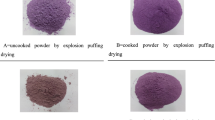Abstract
Orange fleshed sweet potato (OFSP) has been identified as a good source of β-carotene but the β-carotene bioaccessibility is affected by processing. In this study, the effect of traditional heat processing methods on the microstructure and in vitro bioaccessibility of β-carotene from OFSP were investigated. Bioaccessibility was determined using simulated in vitro digestion model followed by membrane filtration to separate the micellar fraction containing bioaccessible β-carotene. Processing led to decrease in the amount of all-trans-β-carotene and increase in 13-cis-β-carotene. Processed OFSP had significantly higher (P < 0.05) bioaccessible β-carotene compared to the raw forms. Bioaccessibility varied with processing treatments in the order; raw < baked < steamed/boiled < deep fried. Light microscopy showed that the microstructure of OFSP was disrupted by the processing methods employed. The cell walls of OFSP were sloughed by the traditional heat processing methods applied. The findings show that heat processing improves bioaccessibility of β-carotene in OFSP and this was probably due to disruption of the tissue microstructure.



Similar content being viewed by others
References
van Jaarsveld PJ, Marais DW, Harmse E, Nestel P, Rodriguez-Amaya DB (2006) Retention of β-carotene in boiled, mashed orange fleshed sweet potatoes. J Food Comp Anal 19:321–329
Wu X, Sun C, Yang L, Zeng G, Liu Z, Li Y (2008) Beta-carotene content in sweet potato varieties from China and the effect of preparation on [beta]-carotene retention in the Yanshu No. 5. Inn Food Sci Emerg Tech 9:581–586
Hornero-Mendez D, Minguez-Mosquera MI (2007) Bioaccessibility of carotenes from carrots: effect of cooking and addition of oil. Inn Food Sci Emerg Tech 8:407–412
Castenmiller JM, West CE (1998) Biovailability and bioconversion of carotenoids. Ann Nutr Rev 18:19–38
Parada J, Aguilera JM (2007) Food microstructure affects the bioavailability of several nutrients. J Food Sci 72:21–32
Aguilera JM (2005) Why food microstructure? J Food Eng 67:3–11
Rock CL, Lovalvo JL, Emenhiser C, Ruffin MT, Flatt SW, Schwartz SJ (1998) Bioavailability of β-carotene is lower in raw rather in processed carrots and spinach in women. J Nutr 128:913–916
Bengtsson A, Namutebi A, Alimnger ML, Svanberg U (2008) Effects of various traditional processing methods on the all-trans-β-carotene content of orange fleshed sweet potato. J Food Comp Anal 21:134–143
Folch J, Lees M, Sloane-Stanley GH (1957) A simple method for the isolation and purification of total lipids from animal tissues. J Biol Chem 226:497–509
Hedren E, Diaz V, Svernburg U (2002) Estimation of carotenoid accessibility from carrots determined by an in vitro digestion method. Eur J Clin Nutr 56:425–430
Oomen AG, Rombelberg CJ, Bruil MA, Dobbe CJ, Perreboom DP, Sips AJ (2003) Development of an in vitro model for estimating the bioaccessibility of soil contaminants. Arch Env Cont Toxicol 44:281–287
Veda S, Kamath A, Platel K, Begum K, Srinivasan K (2006) Determination of bioaccessibility of β-carotene in vegetables by in vitro methods. Mol Nutr Food Res 50:1047–1052
Ruzin SE (1999) Plant microtechnique and microscopy. Oxford University Press, New York
Sweeney JP, Marsh AC (1973) Liver storage of vitamin A in rats fed carotene isomers. J Nutr 103:20–25
Deming DM, Sandra RT, Erdman J (2002) All-trans β-carotene appears to be more bioavailable than 9-cis or 13-cis β-carotene in Gerbils given single oral doses of each isomer. J Nutr 132:2700–2708
Kidmose U, Yang RY, Thilsted SH, Christensen LP, Brandt K (2006) Content of carotenoids in commonly consumed Asian vegetables and stability and extractability during frying. J Food Comp Anal 19:562–571
Ryan L, O’Connell O, O’Sullivan L, Aherne SA, O’Brien NM (2008) Micellarisation of carotenoids from raw and cooked vegetables. Plant Foods Hum Nutr 63:127–133
Haskell MJ, Jamil KM, Hassan F, Peerson JM, Hossain MI, Fuchs GJ, Brown KH (2004) Daily consumption of Indian spinach (Basella alba) or sweet potatoes has a positive effect on total body vitamin A stores in Bangladesh men. Am J Clin Nutr 80:705–714
Mills JP, Tumuhimbise GA, Jamil KM, Thakkar SG, Failla ML, Tanumihardjo SA (2009) Sweet potato β-carotene bioefficacy is enhanced by dietary fat and not reduced by soluble fiber in Mongolian Gerbils. J Nutr 139:44–50
van het Hof HK, Gartner C, Tiljburg LB (1998) Potential of vegetable processing to increase the delivery of carotenoids to man. Int J Vit Nutr Res 68:366–370
Mulokozi G, Hedren E, Svanberg U (2004) In vitro accessibility and intake of β-carotene from cooked green leafy vegetables and their estimated contribution to vitamin A requirements. Plant Foods for Hum Nutr 59:1–9
Huang C, Tang Y, Ching C, Chen M, Chu C, Hseu C (2000) Bioavailability of β-carotene in stir- or deep fried vegetables in men determined by measuring the serum response by a single ingestion. J Nutr 130:534–540
Chandrika UG, Svernberg U, Jansz RE (2006) In vitro acccessibility of β-carotene from cooked Sri-Lankan green leafy vegetables and their estimated contribution to vitamin A requirement. J Sci Food Agric 86:54–61
Jarvis MC, Mackenzie E, Duncan HJ (1992) The textural analysis of cooked potato and swelling pressure of cooked starch during gelatinsation. Potato Res 35:93–102
Acknowledgements
The authors would like to acknowledge the financial support from Carnergie Corporation of New York, Norwegian Agency for Development Cooperation (NORAD) and BTC/CTB. The assistance offered by Mr. Magidu Kisekka, Faculty of Veterinary Medicine, Makerere University, in preparation of OFSP micrographs is highly appreciated.
Author information
Authors and Affiliations
Corresponding author
Rights and permissions
About this article
Cite this article
Tumuhimbise, G.A., Namutebi, A. & Muyonga, J.H. Microstructure and In Vitro Beta Carotene Bioaccessibility of Heat Processed Orange Fleshed Sweet Potato. Plant Foods Hum Nutr 64, 312–318 (2009). https://doi.org/10.1007/s11130-009-0142-z
Published:
Issue Date:
DOI: https://doi.org/10.1007/s11130-009-0142-z




